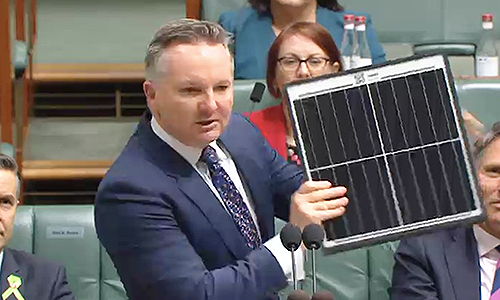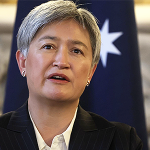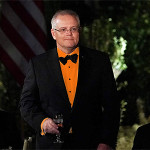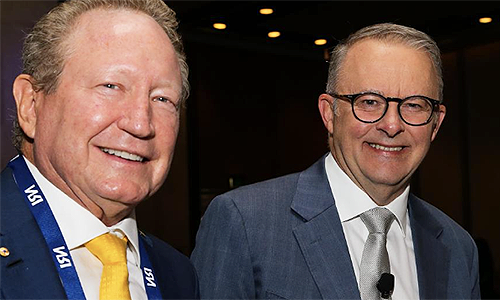
by ROGER CROOK – AUSTRALIA is now inextricably tied to China. If for any reason trade between our two countries should be disrupted, Australia’s economy would rapidly deteriorate and China’s would not.
In 1987 when President Ronald Reagan said “Mr Gorbachev tear down this wall” America was producing about ten times more goods than China. Bob Hawke was Prime Minister of Australia and Paul Keating was Treasurer.
- Australia is the most strategically dependent on China of the Five Eyes nations – by a long way.
- China is virtually the only supplier of solar panels in the world.
- Many of the solar panels exported by China are made by the Uighur slaves.
The total value of our exports was about $50b the same as our imports; China was about three per cent of our export trade and our imports from them were negligible.
Today, China is Australia’s largest two-way trading partner, accounting for 26 per cent of our goods and services trade in 2022-23. Two-way trade with China increased 12 per cent in 2022-23, to total about $317b.
BIGGEST
China is Australia’s biggest market for iron ore, gold, gas and many other mineral concentrates not the least being lithium for the biggest EV manufacturer in the world. China has started buying Australian coal again and the markets for some rural products are increasing.
In the late 80s the Five Eyes Nations; America, UK, Canada, Australia and New Zealand were among the leading advocates of “hyper-globalisation”, another word for Thatcherism.
Margaret Thatcher and Ronald Reagan were the advocates of hyper globalisation and the opening up of world trade without tariffs and other forms of protection.
They wanted to see a deepening of cross border flows of goods, services, capital and people; China saw the opportunity and since that time has benefitted disproportionally from this form of globalisation, causing a fundamental change in its economic and industrial fortunes.
When the COVID pandemic was announced in 2020, China had reached parity with America in the production of goods; four years later China is producing more than America and has become the manufacturing centre of the world. To add insult to injury it now threatens to replace America as the world’s leading vehicle maker.
In 2018, alarmed at the growth of China, a conversation regarding the need for a “decoupling” from the Chinese economy had already started in Donald Trump’s America. One of Trumps main objectives in Making America Great Again was to get American technology out of China and back into what had been America’s industrial heartland.
Decoupling gained currency during COVID when it became obvious to many democratic governments around the world, that they relied on China not only for vital goods like antibiotics, but also for simple things like Personal Protective Equipment (PPE).
That realisation that supplies of PPE, humble plastic disposable clothing was virtually unobtainable when it was most needed humiliated many politicians and health bureaucrats around the world.
EASY
In Australia, iron ore billionaire Twiggy Forrest accompanied by China’s Victorian consul-general, and one-time cyber spy Long Zhou, proved his close links with Beijing and showed how easy it was to embarrass the Australian Minister for Health Greg Hunt, when he magically produced a load of Chinese PPE at the minister’s press conference.
In 2018 as governments began to realise the extent of their dependence on China, the Henry Jackson Society, a well-respected think tank in the UK, decided to have a look at the level of dependence of the Five Eyes nations on goods from China.
They looked at goods that are important to a nation’s infrastructure; they wanted to gain a perspective on what are known as the next generation industries; those industries, which are now emerging as being essential to the achievement of decoupling from an ever-increasing dependence on China.
The Henry Jackson Society looked at the five powers dependency on China across 5910 sets of data, drawn from the United Nations International Trade Statistics Database.
Their study applied three tests to determine whether a country was strategically dependent on China:
- The country had to be a net importer of the goods in question.
- More than half its imports had to come from China.
- China’s global share of the market had to be greater than 30 per cent.
The tests would determine whether, in the event of supplies from China being interrupted, it would be difficult for the importing nation to replace them.
In other words, if the South China Sea was closed for any period of time, how would that affect Australia’s ability to continue with its everyday life and if necessary, defend itself?
The 2018 study found that Australia (surprise, surprise) was the most strategically dependent on China of the Five Eyes nations and by a long way, particularly when compared to the UK, the country that had at one time been our biggest and closest ally.
Out of the 5914 categories of goods imported by the five nations, Australia was strategically dependent on China for 595 of them.
New Zealand came second with 513, followed by America with 414, Canada 367; the least dependent was the UK with 229.
As an example, in 2018 China supplied (I presume still supplies), 86 per cent of all the semi-conductors imported into Australia.
Semiconductors are an essential component of electronic devices, enabling advances in communications, computing, healthcare, military systems, transportation, clean energy and countless other applications.
Without semiconductors the renewable energy industry in Australia – Blackout Bowen’s purpose in life – is dead.
It was found that China supplied 75 per cent of all lighting to Australia; that’s lighting for all the new houses and factories and what is needed for every day replacement. Has anything changed? I doubt it.
Australia relies on China for a staggering 70 per cent of all new computers. Does that also apply to the computers used by our ADF in 2024? If so, it poses the interesting question – could we go to war without China’s support?
If, as many predict, there will be power blackouts and brownouts in the future, fear not; China supplies 75 per cent of all the generators Australia imports. China is there for us – it has our back as it were – but as you will see that is not all.
We are gearing up for a countrywide building boom. China will be happy because they were and still are supplying, depending on the category, between 40 per cent and 100 per cent of all the nuts, bolts, nails, screws etc, which we need to achieve our national construction and engineering objectives.
SPOTLIGHT
Sixty two per cent of all imported radio and television transmitters worth $5b in 2018 were produced in China. Does that bring the ADF back in the spotlight?
Fifty seven per cent of insulated wire and cable, optical fibre cable and nearly 50 per cent of TV receivers were made in China. Similarly, 73 per cent of soldering irons and 70 per cent of resistance welding machines are sourced from China.
Australia is dependent on China for supplies of essential medical equipment and pharmaceutical goods; 69 per cent of all penicillin and its precursors, 72 per cent of certain categories of steel and porcelain sanitary ware, 73 per cent of spectacles and protective goggles and 85 per cent of all first aid kits are made in China.
That was the unenviable position Australia was in in 2018; we were more dependent on China than any of our Five Eyes comrades in arms. There is no reason to suspect that dependency has not increased over the past four years; Labor’s obsession with climate change has seen to that.
In September 2022, Minister for Climate Change Chris Bowen announced that to achieve the Labor Party target for 2030, Australia would need to install forty 7MW wind turbines every month and 22,000 500W solar panels every day for eight years.
At the time of writing Mr Bowen had not given the nation an update on whether we have and still are installing the number of solar panels and turbines he calculated would be needed to become the renewable energy capital of the world; or are the lights going to be dimmed and then fade to black as the coal fired power stations get blown up on schedule?
According to the International Energy Agency, China is virtually the only supplier of solar panels in the world with well over 95 per cent market share; the renewable energy targets set by the Australian Labor Government for 2030 and 2050 cannot be achieved without solar panels made in China.
Solar panels have a life of between 15 and 20 years, and then they have to be replaced. This means that Australia will be totally dependent on China for its renewable energy production and its carbon free status for the foreseeable future and beyond.
TARGETS
If for any reason China is unable to supply Australia with the solar panels it must have to achieve its current targets, plus the extra panels it must have to replace old panels as they reach the end of their life, Australia’s ability to generate renewable electricity will decline; the extent and rate of that decline cannot be calculated, neither can the effect of that decline on the economy be estimated.
If that clean energy disaster happens, China will of course be supplying all the generators we will need to see us through.
It was estimated four years ago that every year between 100,000 to 150,000 panels needed to be replaced in Australia. Researchers at Deakin University also claimed that unless the seemingly impossible challenge of an economically viable method of recycling is found, there will be 1.5m tonnes of toxic solar panels in landfill in Australia by 2050.
There is no commercially profitable way of recycling solar panels; many have tried and as many have failed. South Australia, Victoria and the ACT have banned solar panels from landfill and they are soon to be followed by Queensland.
In America, 27 States have also banned solar panels from landfill because there is mounting evidence that they release harmful toxic heavy metals such as lead, selenium and cadmium.
There is convincing evidence that many of the panels being exported by China are made by the Uighurs in the Xinjiang region in the northwest of that country.
Apparently, the Uighur Muslims are being forced to manufacture solar panels under slave labour and concentration camp conditions; they are also being re-educated by the CCP in an attempt to force them away from their religion.
The Australian Labor Party and many in the developed world, eager as ever to voice opinions on Israel, have turned their backs on the sufferings of the Uighur people, all in the name of their climate change gods.PC












While looking for information on Small Modular Reactor technology (SMR) I came across the article link below explaining that there is now a technology race between nations to capture the future nuclear energy based electricity generation market, noting that China is the present leader in wind and solar equipment sales worldwide.
At the recent Climate Conference many UN member nations advised that they intend to increase nuclear power station capacity or if not already operating nuclear to build nuclear power stations in the near future.
Wind and solar hybrid electricity supply has proven not to be efficient, reliable or cost effective.
But no doubt Chinese manufacturers like the average 20 year until removal and replacement of installations, as compared to coal fired power stations that in Australia are retired after 50 years but could be maintained to continue for at least 70 years.
And power stations not reliant on sunshine and wind to operate.
https://edition.cnn.com/2024/02/01/climate/nuclear-small-modular-reactors-us-russia-china-climate-solution-intl/index.html
Is it any wonder China is building hundred of coal fired generators when it will be the largest ( by far) manufacturer in the World within 10 years.
Nuclear also being operated and more being built in China, the major benefits being no constant refuelling to operate and zero emissions.
However it is woke stupidity ignoring Australia’s abundance of high quality black coal, lignite/brown coal and gas fuels for steam turbine powered generators in power stations. The latest ultra supercritical boiler technology produces much lower emissions that the fleet of power stations here, even lower than the couple of the most recently built HELE high energy low emissions technology located in Queensland.
And by utilising the existing power station locations for any replacement power stations required,, and nearby main electricity grid network, and the Transition plan Renewable Energy Target abandoned, no new land would be needed including no additional transmission lines feeding from every wind or solar location to the main grid.
Small Modular Reactor technology is produced ready to install in the manufacturer’s factory and also if needed pre-fabricated building to house a complete generator system. Or SMR can replace the coal fired boiler system in existing power stations.
Nuclear energy can be used for many applications, the one reactor in Australia at Lucas Heights Sydney produces radio isotopes for nuclear medicine uses and commercial applications. It is the second on site, the original was built in the 1950s and operated safely until it was replaced.
“the major benefits being […] zero emissions.”
“Zero emissions” are only a “benefit” in the minds of those who have zero neurons.